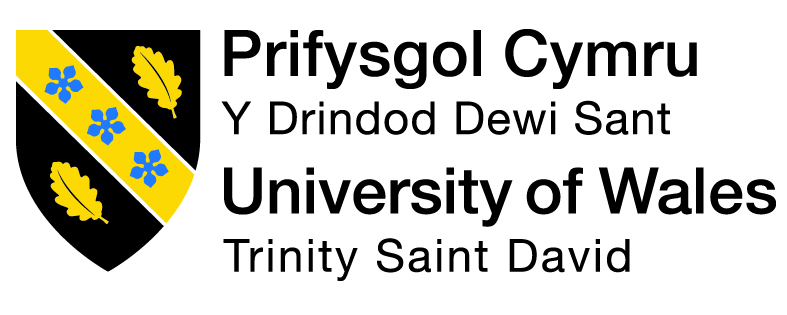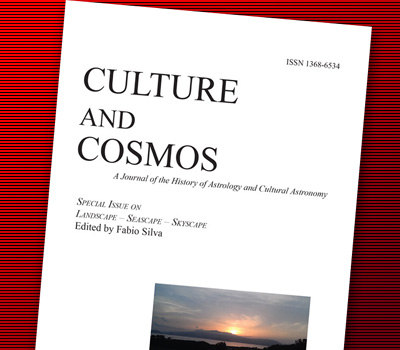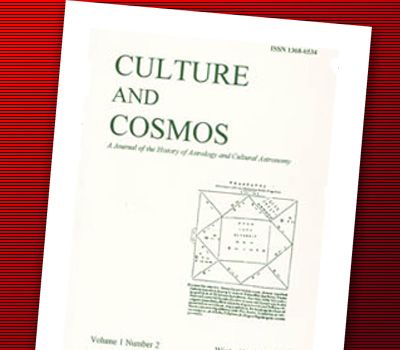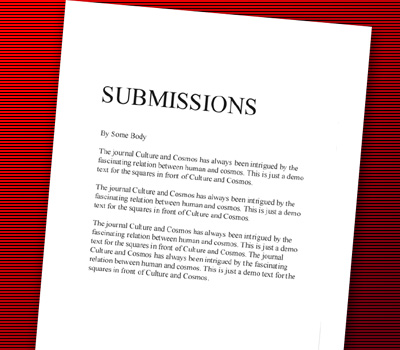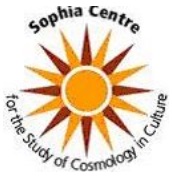We are currently seeking submissions for future volumes of Culture and Cosmos.
Volume 7, No. 1
Introduction: Galileo's Life and Work
Nicholas Campion
Abstract
Galileo Galilei was, by virtue of his work for the Medici family, one of the premier astrologers of early seventeenth-century Europe. The evidence suggests that, like his friend and colleague Johannes Kepler (1571-1630), he saw some need to reform astrology in order to bring it into line with the politics and cosmology of his age. Yet, his astrological technique remained rooted in tradition. In the words of Bernadette Brady in this volume, he may have been the 'last man standing', the last of the great medieval astrologers.
Galileo also remains one of the most controversial of scientists. The persecution which resulted from his public advocacy of the new Copernican sun-centred universe was immortalized by Bertolt Brecht's well-known play. To this day Galileo remains an icon of the enlightened scientist confronting the dark forces of superstition. This special issue of Culture and Cosmos is published to commemorate Galileo's arraignment on charges of astral fatalism four hundred years ago, in 1604.
Galileo was born at or near Pisa on 15 February 1564. In 1581, at the age of seventeen, he enrolled at the university of Pisa to study medicine but was diverted by a fascination for mathematics, a discipline he pursued with such success that he was appointed to the chair of mathematics at Pisa in 1589. In 1592 he moved to Padua, where he taught until 1610, spending most of this time dealing with problems of motion. He was not initially a Copernican. His earliest surviving composition, the De universo, probably written in 1584, explicitly rejected Copernicanism for both philosophical and astronomical reasons. In 1590, though, he appeared to be changing his views, and in his lost commentary on Ptolemy's Almagest he appeared to support a mixed system, not unlike Brahe's. In 1597 he told Kepler that he was sympathetic to Copernicanism, a conclusion he reached on philosophical grounds, although apart from that he showed little concern with astronomy, his main concern being the explanation of motion. However, during the appearance of the supernova of 1604 he gave public lectures attacking the by now extremely vulnerable Aristotelian doctrine of the immutability of the heavens. In the next year, 1605, he tutored Cosimo II de Medici in one of the Medici villas outside of Florence.
Galileo's interest in observational astronomy was sparked in 1609 when, hearing about the newly invented telescope, he constructed his own crude instrument and began to examine the heavens. He quickly discovered that the moon was covered with mountains and pitted with craters, rather than being the perfect sphere envisaged by Aristotle. Far more sensational though, were the four satellites he discovered orbiting Jupiter. If anyone still hung on to the Aristotelian cosmology after the new stars of 1572 and 1604 then the discovery of Jupiter's first four must have finally convinced them that the entire universe was filled with the potential for change. Galileo lost no time in announcing his discovery in the Siderius Nuncius - Starry Messenger - of 1610, the same year that Kepler published the Tertius Interveniens, his major work on astrology. Galileo named the new moons the Medicean stars in honour of the Medici family, an overt appeal for patronage that appealed to Cosimo II's belief that the clan's glorious destiny was uniquely represented in the heavens. Galileo was rewarded later in the year when Cosimo appointed him court mathematician and philosopher - that is, astrologer.
Galileo's discovery of Jupiter's moons was followed by three other remarkable discoveries - the sun's rotation, sunspots and the phases of Venus - all of which added further nails to the coffin of Aristotelianism. The latter, which can be explained only if Venus orbits the sun, provided convincing observational evidence for Copernicanism, which he publicly defended in 1613 in his Letters on Sunspots.
Whereas Copernicus had been extraordinarily cautious in the promotion of his heliocentric theory, Galileo, like St. Paul, was an evangelist. He ignored Kepler's discovery that the planets move in elliptical orbits. For him Copernicus was enough. He recognised that the Catholic Church, like the rest of European society, had automatically assumed the truth of the Aristotelian cosmology, and set out to persuade it that henceforth Copernicus was the new authority. In 1613 he began arguing that scripture and heliocentricity were compatible as long as one realised the Bible was primarily metaphorical, a perfectly reasonable line to take. The church authorities began to take notice and in 1616 a commission under Cardinal Roberto Bellarmine forbade only two things; attempts to reconcile Copernicanism with the Bible (an effort that the church clearly thought was its responsibility) and the assertion of literal truth for heliocentric theory. Copernicus' De Revolutionibus was suspended pending the removal of selected passages, one on Biblical exegesis and others in which the earth was called a 'star', implying it moved like a planet. The Catholic church's attitude seemed to be more concerned with its own authority to speak on Biblical matters than with heliocentricity as such, and Copernicans were not suppressed - they merely tended to adopt a cautious approach, treating Copernicanism as merely one hypothesis rather than, as Galileo's observations had demonstrated, the truth.
In 1623 Maffeo Barberini, an admirer of Galileo, was elected pope under the name Urban VIII. The following year the astronomer, who had justifiable hopes that the 1616 edict might be eased, visited Rome and was granted no less than six audiences. He began working on a book to be titled Dialogue on the Tides to show that a valid reason for discussing the motion of the earth was its possible relationship with the tides. It was shown to the censors, who removed anything that might violate the 1616 edict, and to the Pope, who ordered the removal of the word 'tides' from the title, lest it be thought that the church was endorsing that particular theory. The book appeared in 1632 under the simple title Dialogue (since 1744 it has been known as the Dialogue Concerning the Two Chief World Systems). Constructed like Platonic dialogues, the Dialogue's three participants discussed the merits and problems involved in both the geocentric and heliocentric systems. In spite of the fact that the book was published with the church's permission, an anonymous charge of heresy levelled against its author resulted in Galileo's famous investigation by the Inquisition. Even though Galileo had the weight of legal evidence on his side, seven of the ten cardinals who sat in judgement on him condemned him; he agreed to recant his views and submitted to life-long house arrest. Even hypothetical discussion of Copernicanism became evidence of heresy and the Catholic church backed itself into a corner in which its chosen cosmology was increasingly regarded as manifestly absurd.
There is considerable uncertainty over the exact nature of the church's argument with Galileo. It has been suggested that his real crime was publicly to challenge the authority of a Catholic hierarchy that in fact included many who were sympathisers or supporters, or even that the heliocentric issue was less of a problem than his atomic theories, which undermined the doctrine of transubstantiation (the conversion of the bread and wine into the body and spirit of Christ in the mass).
Nevertheless Galileo developed his ideas further in the Discourse on the Two New Sciences in 1638, a text which is credited with laying the foundation of modern physics. Whereas the astronomies of Copernicus, Brahe and Kepler were designed to fit in with Aristotelian physics, Galileo applied a new physics based on his studies of motion.
Galileo's work was much more dramatic than Copernicus' and had an immediate effect on European thought. It really did demolish the old Aristotelian structure of the solar system overnight. One of the first public reactions was published by the English poet John Donne. In his Anatomy of the World, written in 1611, the year after Galileo's first observations, he wrote,
And new philosophy calls all in doubt,
The element of fire is quite put out,
The sun is lost, and th' earth, and no man's wit
Can well direct him where to look for it.
And freely men confess that this world's spent,
When in the planets, and the firmament
They seek so many new.
'Tis all in pieces, all coherence gone.

